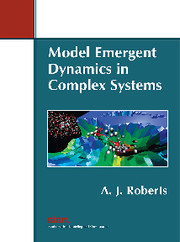Description
Model Emergent Dynamics in Complex Systems
Author: Roberts A. J.
Language: English
Subject for Model Emergent Dynamics in Complex Systems:
Publication date: 05-2015
760 p. · 17.9x25.4 cm · Paperback
Withdrawn from sale
760 p. · 17.9x25.4 cm · Paperback
Withdrawn from sale
Description
/li>Contents
/li>Biography
/li>
Arising from the growing interest in dynamical systems theory, this book explores the derivation of relatively simple dynamical equations that model complex physical interactions. It unifies into one coherent approach many varied extant methods for model reduction and approximation. Using mathematical models at various levels of resolution and complexity, the book establishes the relationships between multiscale models and paradoxes, and addresses model reduction for systems, resolves initial conditions, and illuminates control. The methodology focusses on the geometric picture of both coordinate transforms and invariant manifolds in dynamical systems leading to a broad range of geometric interpretations of the modeling process that it produces. This facilitates an enhanced view of other modeling methodologies such as averaging, homogenization, multiple scales, singular perturbations, and WKB theory. Researchers at the graduate level and above who need to understand systems and modeling at different levels of resolution and complexity will find this book useful.
Preface; Part I. Asymptotic Methods Solve Algebraic and Differential Equations: 1. Perturbed algebraic equations solved iteratively; 2. Power series solve ordinary differential equations; 3. A normal form of oscillations illuminate their character; Part I summary; Part II. Center Manifolds Underpin Accurate Modeling: 4. The center manifold emerges; 5. Construct slow center manifolds iteratively; Part II summary; Part III. Macroscale Spatial Variations Emerge from Microscale Dynamics: 6. Conservation underlies mathematical modeling of fluids; 7. Cross-stream mixing causes longitudinal dispersion along pipes; 8. Thin fluid films evolve slowly over space and time; 9. Resolve inertia in thicker faster fluid films; Part III summary; Part IV. Normal Forms Illuminate Many Modeling Issues: 10. Normal-form transformations simplify evolution; 11. Separating fast and slow dynamics proves modeling; 12. Appropriate initial conditions empower accurate forecasts; 13. Subcenter slow manifolds are useful but do not emerge; Part IV summary; Part V. High Fidelity Discrete Models Use Slow Manifolds: 14. Introduce holistic discretization on just two elements; 15. Holistic discretization in one space dimension; Part V summary; Part VI. Hopf Bifurcation: Oscillations Within the Center Manifold: 16. Directly model oscillations in Cartesian-like variables; 17. Model the modulation of oscillations; Part VI summary; Part VII. Avoid Memory in Modeling Nonautonomous Systems, Including Stochastic: 18. Averaging is often a good first modeling approximation; 19. Coordinate transforms separate slow from fast in nonautonomous dynamics; 20. Introducing basic stochastic calculus; 21. Strong and weak models of stochastic dynamics; Part VII summary; Bibliography; Index.
A. J. Roberts is a Professor and Chair in the School of Mathematical Sciences at the University of Adelaide. He has lectured and conducted research at the University of New South Wales and the University of Southern Queensland and has published over 100 refereed international journal articles. As a leader in developing and applying a branch of modern dynamical systems theory, in conjunction with new computer algebra algorithms in scientific computing, Professor Roberts derives and interprets mathematical and computational models of complex multiscale systems, both deterministic and stochastic.
© 2024 LAVOISIER S.A.S.
These books may interest you

Random Dynamical Systems in Finance 160.25 €


